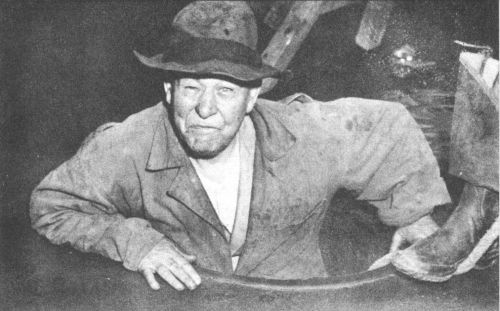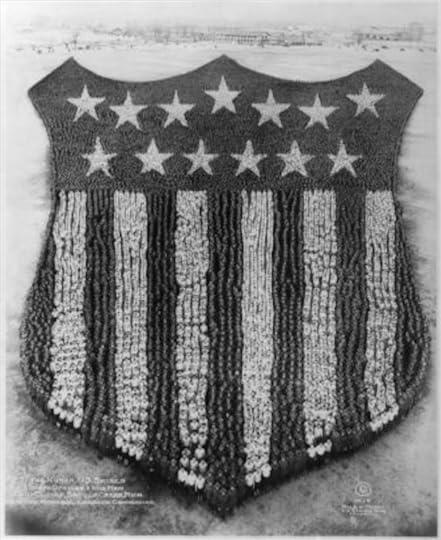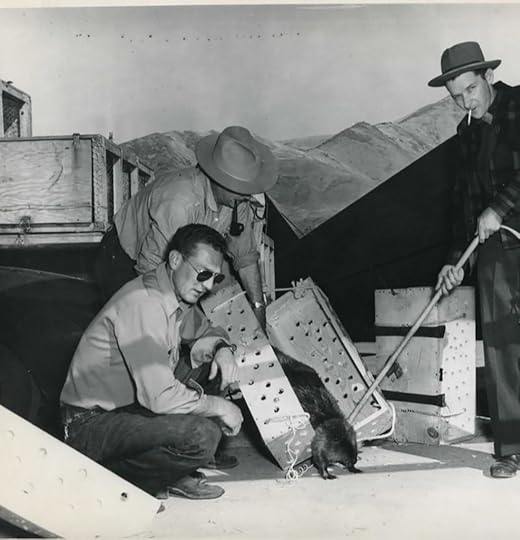Ripley Entertainment Inc.'s Blog, page 333
July 5, 2018
Idaho Relocated Beavers By Parachuting Them From Planes
Featured in Ripley's Believe It or Not!

I’ve thought long and hard about exactly how to say this delicately, but I haven’t come up with anything, so I’m just going to say it. A government agency in America once dropped beavers out of a plane!
In a day when PETA will sue or protest if you so much as look at an animal wrong, it’s unbelievable to me that someone could have once just tossed animals out of a plane with impunity.
Eager Beavers
Maybe the real story isn’t as bad as all that sounds, but it’s still jaw-dropping.
The year was 1948. It was three years past the end of WWII, and people were starting to migrate into the beautiful area of Payette Lake in McCall Idaho.
In typical human fashion, they didn’t stop to consider the natives, in this case, the beaver population.
It didn’t take long for the residents of Payette Lake to figure out that living with busy beavers wasn’t going to be easy, so they decided the best bet was to move them to a new habitat.
Relocation
The questions for Idaho Fish and Game were where and how to move the little guys. Luckily, Elmo Heter worked in the department at the time, and he had experience with the critters, making him the closest thing to an expert the government had.
Heter knew that Chamberlain Basin was the perfect spot for the beavers. But the aspects of the basin that made it such an ideal destination (it’s remoteness and dense vegetation) also made it complicated to get the beavers to their new home in the first place. There are no roads leading into the basin, so cars were out of the question.
They might have packed the animals in boxes and strapped them to donkeys, but apparently beavers and donkeys don’t mix.
Horses and mules become spooky and quarrelsome when loaded with a struggling, odorous pair of live beavers.
Which left them with the only logical solution: drop the beavers from planes.

There are beavers in those boxes!
Geronimo
 Heter knew there was a surplus of parachutes left over from WWII. The plan seemed to be coming together. Heter could get the beavers out of the community and move them into a place where they could be happy and do some real good, all while getting rid of the parachutes too.
Heter knew there was a surplus of parachutes left over from WWII. The plan seemed to be coming together. Heter could get the beavers out of the community and move them into a place where they could be happy and do some real good, all while getting rid of the parachutes too.
So he designed a box that would fit a beaver and open upon impacting the ground. Then he tested it. First, he used weights, and then he found a male beaver, named him Geronimo, and started regularly dropping him from a plane.
Poor fellow! He finally became resigned, and as soon as we approached him, would crawl back into his box ready to go aloft again.
Once he was confident the plan would work, Heter made Geronimo the first official transplant and sent three female beavers with him.
Thereafter, 76 more of the little critters followed him along. All but one of the skydivers survived the trip and went on to work wonders for the natural habitat of the basin.
Say what you will about the craziness of Heter’s plan; the fact is it worked. And now we can all sit back and marvel at the fact that back in the 1940s, it rained beavers over Idaho.
Source: Idaho Relocated Beavers By Parachuting Them From Planes
Could Alligators Survive In The Sewers Of New York City?
Featured in Ripley's Believe It or Not!

Originally stemming all the way back to the 1930s, but really taking hold of the collective imagination of Americans in the 1950s, stories have persisted over the decades that alligators have been spotted—and live—in the sewers of New York City mainly, but in other cities, as well.
Tales of alligators living and breeding in New York City’s sewer system in the ’30s seem to originate to then Commissioner of New York City’s Sewers, Teddy May. May was reported as saying several inspectors spotted alligators in the cities’ underground tunnels circa 1935. Without any real proof of their existence, May set about to rid the city of the phantom gators. Using poison bait and luring them into the cities’ main tunnels, hunters stood on guard, rifles in hand waiting for the massive reptiles.

Sewer commissioner Teddy May
No sightings of the alligators were filed during the campaign. However, in 1937, May declared the cities’ sewers were safe for rodents and waste products, once again.
In the 1950s, stories of alligators in NYC sewers caught the imaginations of Americans all over again. This time, the story had changed a bit. Stories would focus on families vacationing in Florida, bringing live baby alligators with them back to New York. Once those little critters grew too big, said family would flush the gator down the toilet and into the sewer system. As legend has it, the alligators would feast on rats and trash, growing to enormous sizes. The alligators would turn albino along the way—due to the lack of sunlight—and menace the population at large.
No concrete proof of alligator—albino or otherwise—has ever surfaced.
And while a two-foot alligator was found in the sewers near a restaurant in New York City back in 2010—which is not the 50s—it’s very unlikely that gator would have survived much longer in that environment.
The Reality
Why? Why would it be unlikely for a gator to survive, let alone grow to massive lengths in the NYC sewer system? Primarily because alligators are reptiles, which are cold-blooded animals. Meaning, they can not regulate their body temperatures on their own as humans do—via sweating to cool off or shivering to warm up.
In order to survive, alligators need to warm their bodies by basking in the sun or under a heating lamp for several hours. Which, living in the NYC sewer system doesn’t provide. Without the warmth of the sun, alligators end up in a state called “torpor,” where primary bodily functions all but cease. And while, they can survive several months in this state—like throughout winter—without eventual exposure to the sun, gators would eventually die.

And, no, even in the unlikely event that an alligator did manage to survive for any length of time in the cold, darkness of a sewer, it wouldn’t turn albino. Albinism is a mutation in the genetic code that occurs during the gestation process. Animals don’t lose skin pigment in the absence of light. They just get cranky and depressed.
By Jesse Gormley, contributor for Ripleys.com
Source: Could Alligators Survive In The Sewers Of New York City?
CARTOON 07-05-2018
July 4, 2018
The Daredevil Magician: Harry Houdini
Featured in Ripley's Believe It or Not!

A child immigrant from Hungary, the man who would become known as Harry Houdini got his start in the entertainment world in 1891 traveling with a circus of strongmen. Known as the “King of Cards” for a short while, fellow magicians saw Houdini as a man with some skill, but nothing that truly impressed them.
Houdini may not have had the card skills to impress fellow tradesmen, but his talent for escape seemed unparalleled. Known to shrug off straitjackets, slip out of handcuffs, and wriggle out of ropes, Houdini began his journey of facing mortal danger head-on while wondering how he could make the task harder.
As Houdini’s name and prowess grew, so too did his arsenal of illusions. He became obsessed with tricks, performing them in both closed theaters and as open publicity stunts. In one trick, he swallowed needles and thread and then had himself buried alive on stage. When he burst from his coffin minutes later he would regurgitate the needles, threaded with the cotton!
No Handcuffs Could Hold Him
Houdini’s signature stunt was escaping handcuffs. Many times he would challenge the police to lock him up however they could on the street, then he’d jump in a nearby river and emerge totally free. He found the task so easy that he challenged anyone in the world to make a pair of handcuffs that could hold him. One firm spent five years designing a pair, certain they would claim the prize, but Houdini escaped in minutes, tarnishing their years of work.
Submerged Stuntman
Speed increasingly became a cornerstone of Houdini’s repertoire. To add danger to his performances, he began having himself submerged in water while he escaped. In 1912, he was secured by his feet upside down and dunked in a watertight chamber. He escaped the cell in minutes, though one time he broke his ankle.
A Houdini trademark, he asked that the water prison be burned upon his death. Though Houdini’s brother kept the cell intact, it was eventually burned in 1995 during a museum fire.

Another stunt involved Houdini being locked inside a water-filled milk can, escaping while behind a curtain. For public displays, Houdini would be hoisted high into the air wearing a straitjacket, and escape unharmed before crowds of onlookers.
The Final Act
Though Houdini defied death countless times, putting himself into all sorts of danger, the magician died of appendicitis. Known for having a high pain tolerance, a fan asked to punch Houdini as hard as he could in the stomach. Houdini obliged, but it would be his last stunt. He didn’t seek medical attention for days, leading to his death.
4th of July Unboxing Extravaganza!
Featured in Ripley's Believe It or Not!

In This Episode
Fire up the grill—it’s 4th of July weekend! From a massive scrap metal eagle to Mike Drummond’s miniature Statue of Liberty carved into a toothpick, this week’s episode is peculiarly patriotic.
Today: ‘MERICA
Share & Subscribe
If you liked the show, please share it with your peeps. Remember to SUBSCRIBE to our channel to stay BION-informed!

If you think this episode’s scrap metal eagle was big, or Len Hughes’ matchstick replica of the Statue of Liberty was intricate, get ready for patriotic photographer Arthur Mole!
Patriotic Portraits
Arthur Mole was a photographer with an unusually large imagination, taking pictures of tens of thousands of painstakingly organized soldiers on the ground using a regular camera from an 80-ft tower. Viewed from this height, the troops formed vast portraits of patriotic and military symbols.

Mole’s largest work saw 30,000 men carefully placed to create this Human U.S. Shield at Camp Custer in Battle Creek, Michigan.

Mole’s Human Statue of Liberty was almost eight times the height of the real statue in New York.
Working as a commercial photographer in Chicago in the early 20th century, Mole saw an opportunity to make inspiring pictures that would encourage support for U.S. troops during World War I. He would spend at least a week organizing each photograph with his colleague John Thomas, directing the assembled troops with a megaphone according to a picture drawn on the lens of his camera. Assistants would then trace the outline with extremely long pieces of lace, enabling him to determine precisely how many troops he would require for each photograph.
Arthur Mole’s most famous creations were captured in 1918. Twenty-five thousand soldiers from Camp Dix, New Jersey, stood as one to create The Human Liberty Bell, and 18,000 men assembled to Mole’s orders in a vast rendering of the Statue of Liberty that stretched for 1,200 ft.
Possibly his most dramatic image involved 21,000 men at Camp Sherman, Ohio, to make The Living Portrait of Woodrow Wilson—the U.S. president at the time.

The Human Liberty Bell, made with the help of 25,000 troops.
CARTOON 07-04-2018
July 3, 2018
Cannibal Fork From The Fiji Islands
Featured in Ripley's Believe It or Not!

When European explorers landed in the Fiji Islands in the late 18th century, they were astounded by the brutality and widespread practice of cannibalism.
Evidence of cannibalism has been found as far back as 500 b.c., with saw and butcher marks apparent on human bones. By the 1800s—with the arrival of European weaponry and Christian missionaries—Fijian culture underwent dramatic change. Trading sea cucumbers for guns, they quickly sought power. One tribe even managed to use the guns they had obtained to commandeer a ship with cannons to attack neighboring tribes.
During the same time that war broke out, missionaries began changing their cultural practices, forcing them to dress differently and end their marriage and funeral rituals. As conflicts broke out, missionaries were killed and eaten. The reasons for cannibalism varied throughout its millennia-old history, but, at the time, cannibalism was regarded by islanders as the ultimate sign of disrespect.
Cannibalism rituals were brutal, and many observers report the bodies would be treated with the utmost savagery. As the flesh cooked in the skin burned, tribe members would twist off bits of meat with specially-carved cannibal forks. Some members of the tribe—like priests and shamans—were forbidden from touching the “unclean” meat and would be fed by other tribe members.
The most prolific cannibal is said to have consumed 872 people. Chief Ratu Udre Udre would place a stone in a pile every time he ate a person to keep a record of his battle achievements. Rumors and legends abounded among Europeans about Fiji, and they became popularly known as the Cannibals Isles across the world.
As attacks on missionaries persisted, punitive expeditions were sent to the islands in some cases to wholly exterminate tribes. The islands experienced a brief native confederacy before imperialist powers took control. Widespread cannibalism ended before the turn of the century, with tales only persisting to encourage tourism. Today, cannibalism remains a part of their history, but villages have since formally apologized to the descendants of the people they ate.
Radball is an Official Sport: Soccer Played on Bicycles
Featured in Ripley's Believe It or Not!

It is estimated that more Americans are watching the FIFA World Cup than ever!
But What If You Played Soccer On Bikes?
Then you’d be playing Radball.
The first official radball tournament was more than 80 years ago in 1930. Radball has a solid rulebook, essentially using soccer’s rules, except players are not allowed to hit the ball with their feet:
You must use the bike to pass, travel, and kick into a goal.
You have to stay on your bike.
While the goalkeeper is allowed to use hands, he must also remains on his bike.
Since the first tournament in 1930 there’s been a world cup every year.

The cup lasts twice as long as the NFL season. And luckily enough, you can still watch this year’s!
The 2015 radball Season began the 16th of May and ended seven months later!
Rad!
The “rad” in radball isn’t just shorthand for radical; it comes from German’s “rad,” meaning “wheel.” Literally translated, it’s “wheelball”. In other places you’ll find this ridiculous sport also called “Cycle Ball”
Regardless, it deserves the famous name because it is certainly a German-dominated sport: Since 1956, 59 gold medals that have been awarded and only 11 of the 59 gold have not been won by Germany… Two of those 11 were to East Germany.
So if you’re placing bets this year, Germany wins more than 80% of the world cups AND won the last 10 consecutive cups. And in second place is Switzerland with 8 golds, but they haven’t won since 1985!
If you missed last season, the official UCI (International Cycling Union) put together an official highlight reel you can watch above!
Newsletter Subscription (Sidebar)
Sign up for our Newsletter and get weird news and exclusive offers to Ripley's, delivered straight to your inbox!
*

Source: Radball is an Official Sport: Soccer Played on Bicycles
CARTOON 07-03-2018
July 2, 2018
Burning Ballet Dancers Of The 19th Century: Tragic Tale Or Sinister Conspiracy?
Featured in Ripley's Believe It or Not!

Ballet dancers are often considered to suffer more for their art than any other individuals of artistic practice. However, in the mid to late 1800s, there was an even more dangerous side to being a ballerina: the gas lamps that lined the stage could catch the filmy skirt of a tutu and set the dancer up in flames!
The “Holocaust of Ballet Dancers” (and What Could Have Been Done to Prevent It)
 The term was actually used to describe the deaths of multiple dancers who were met with tragic accidents on the stage. Perhaps the most famous dancer who lost her life this way was Emma Livry, who was rehearsing La muette de Portici in Paris and fluffed her skirt near a gas lamp, causing her to catch fire. She died over a year later from complications of the burns she sustained. Some dancers were lucky enough to simply experience small burns and return to dancing afterward, but others were not so lucky.
The term was actually used to describe the deaths of multiple dancers who were met with tragic accidents on the stage. Perhaps the most famous dancer who lost her life this way was Emma Livry, who was rehearsing La muette de Portici in Paris and fluffed her skirt near a gas lamp, causing her to catch fire. She died over a year later from complications of the burns she sustained. Some dancers were lucky enough to simply experience small burns and return to dancing afterward, but others were not so lucky.
These deaths could have been prevented, making them all the more tragic. An imperial decree in Paris was set forth in 1859, which stated that costumes must be carteronized—dipped into a chemical compound known as alum to protect them from catching fire. This, however, made the costumes dingy-looking as well as stiff and hard to move around in, which is why many ballet dancers refused to utilize the solution.
Who Was to Blame?
On one hand, the ballet dancers themselves often refused to carteronize their costumes, stating they wanted to be able to dance to the best of their abilities in order to please their audiences. Emma Livry was one of the most adamant critics of the decree, stating in a letter to the director of the Paris Opera House, “I insist, sir, on dancing at all first performances of the ballet in my ordinary ballet skirt.” Many historians point out the interesting nature of this dissension, especially since it marks a definite difference between the old world of ballet, where the dancers held more power, and the new, where the power is mostly in the hands of the directors. Some even state that the frequent injuries and deaths of ballet dancers at this time was one of the catalysts for this change, stripping these women of their ability to refuse certain aspects of the job and putting it in the hands of those who had the bigger picture in mind.

However, there is another theory that the dancers themselves were not to blame. After Livry’s death, new safety measures were created such as wire frames for the gas lamps and fireproof ballet skirts. Many question why these changes weren’t put into place years before, which would have prevented a number of the tragic deaths. After all, the creation of fireproof materials (including clay, plaster, and yes, even clothes) had already been well underway in theaters since the mid-1600s, and other easy changes (like putting fireproof blankets in the wings) took too long to become implemented. In fact, some historians believe that the possibility of a ballet girl going up in flames was too exciting for managers and directors to pass up, especially when it added a real sense of danger to every performance.
Was the entire holocaust of ballerinas avoidable? If so, does the blame fall on the dancers willing to risk death for the beauty of their art or on the promoters, directors, and other men who should have protected them but saw too many opportunities to claim additional money and power in the event of their potential deaths?
By Julia Tilford, contributor for Ripleys.com
Source: Burning Ballet Dancers Of The 19th Century: Tragic Tale Or Sinister Conspiracy?
Ripley Entertainment Inc.'s Blog
- Ripley Entertainment Inc.'s profile
- 52 followers







